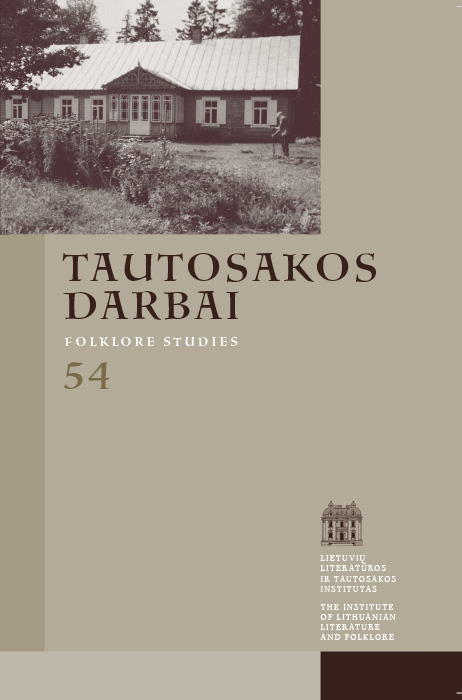Nedaryk kitam blogo, bo pats gausi slogą: slogos ir slogučio ryšiai lietuvių tautosakoje
Santrauka
Straipsnyje pristatomi slogos sampratai lietuvių liaudies medicinoje skirto tyrimo rezultatai. Nagrinėjant vieną tikėjimą, priskiriantį slogą prie limpamų (užkrečiamų) ligų, buvo pastebėta, jog šis susirgimas lietuvių liaudyje turėjo net kelis tarminius pavadinimus, be to, sloga galėjo būti vadinama ir naktimis žmogų kankinanti mitinė būtybė – slogutis. Išanalizavus etiologines ir mitologines sakmes, tikėjimus bei kitų šalių tautosakinį kontekstą išryškėjo slogučio kaip ligos samprata. Nors tautosakos duomenų stygius neleidžia kalbėti apie slogą-rinitą ir slogą-slogutį kaip užkrečiamą ligą lietuvių liaudies medicinos sistemoje, buvo išryškintos šių dviejų susirgimų sąsajos, leidžiančios kalbėti apie ligos suvokimą dviem aspektais – kaip vidinės ir kaip išorinės.
Atsisiuntimai
Skaitomiausi šio autoriaus(ų) straipsniai
- Asta Skujytė-Razmienė, Iš naujo apie dievą Perkūną , Tautosakos darbai: T 67 (2024): Tautosakos darbai
- Jurga Sadauskienė, Austė Nakienė, Rytis Ambrazevičius, Asta Skujytė-Razmienė, Radvilė Racėnaitė, Gražina Kadžytė, Modesta Liugaitė-Černiauskienė, Vita Džekčioriūtė-Medeišienė, Eligija Garšvienė, Kronika , Tautosakos darbai: T 54 (2017)
- Asta Skujytė-Razmienė, Veneros palytėti: sifilio samprata ir gydymas XX a. pirmos pusės Lietuvoje , Tautosakos darbai: T 69 (2025): Tautosakos darbai
- Rūta Žarskienė, Inga Vidugirytė, Asta Skujytė-Razmienė, Gražina Kadžytė, Lina Leparskienė, Vita Džekčioriūtė-Medeišienė, Dalia Zaikauskienė, Kronika , Tautosakos darbai: T 58 (2019)
- Asta Skujytė-Razmienė, Maro ir choleros kilmė lietuvių tautosakoje , Tautosakos darbai: T 52 (2016)
- Radvilė Racėnaitė, Rūta Žarskienė, Živilė Ramoškaitė, Asta Skujytė-Razmienė, Aušra Žičkienė, Kronika , Tautosakos darbai: T 51 (2016)
- Jūratė Šlekonytė, Asta Skujytė-Razmienė, Gražina Kadžytė, Austė Nakienė, Vita Džekčioriūtė-Medeišienė, Kronika , Tautosakos darbai: T 56 (2018)
- Guntis Pakalnas, Rimantas Sliužinskas, Asta Skujytė-Razmienė, Radvilė Racėnaitė, Vita Ivanauskaitė-Šeibutienė, Rūta Žarskienė, Lina Leparskienė, Andželika Jakubynienė, Kronika , Tautosakos darbai: T 47 (2014)
- Radvilė Racėnaitė, Asta Skujytė-Razmienė, Ainė Skudutytė, Povilas Krikščiūnas, Gaila Kirdienė, Austė Nakienė, Rūta Žarskienė, Kronika , Tautosakos darbai: T 50 (2015)
